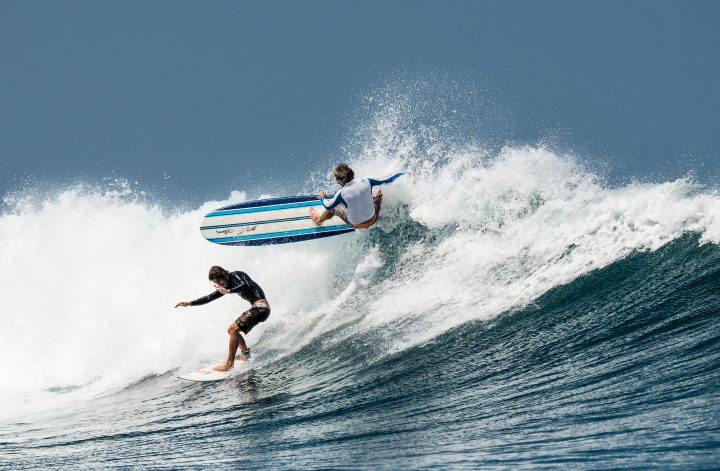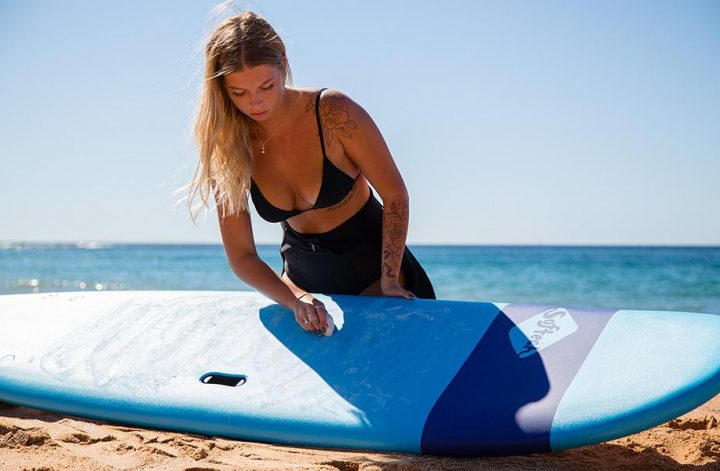So it’s decided – today’s the day – you’re going to start surfing. Go you! Now all that’s left to do is work out which surfboard to choose. As you already know, there are lots of different shapes and sizes – and even big differences in construction, like whether the surfboard is a soft top (made out of foam) or a hard top (which can be made out of a few different materials).
In this article we’ll break down the pros and cons of each surfboard type, and give you some pointers and tips on choosing the right hard or soft surfboard for you.
Soft Top Surfboards
Softboards – sometimes affectionately known as ‘foamies’ – are as the name implies; soft and made out of foam. If you’ve tried surfing before, chances are it was a foamie as these are the most common type of beginner’s surfboard.

Why Choose a Softboard?
There are a number of reasons you may want a soft surfboard to be your first purchase. In our experience there are three main pros to factor into your decision-making:
1. Volume & Buoyancy
You probably know that surfboard volume and buoyancy are important factors in finding the right surfboard for you. You can read more about this topic in another article we wrote: How To Calculate My Surfboard’s Volume. Basically, a soft surfboard’s large volume plays an important part in helping beginner surfers learn to balance on the board. The foam material adds extra buoyancy which can make it easier for beginner surfers to paddle and ultimately catch a wave.
2. Less Chance of Getting Hurt
It’s no surprise that being hit in the face with your surfboard after being rolled by a wave can hurt. A lot. With a foam surfboard, your risk of injury is lower as the board is softer. This means when you collide with the board the hits are padded so you won’t get hurt as much compared with a hard surfboard. This will also benefit the surfers around you (especially as you learn surf etiquette).
3. The Cost
As foamies are mostly used by beginner surfers and are usually a ‘gateway board’ to your life in surfing, soft surfboards are generally affordably priced. It would be unusual to find a softboard priced higher than performance shortboards, for example. Click here to see a range of softboards and their prices.
The Cons of Buying a Soft Top Surfboard
With every upside, there are of course downsides – and that’s also true of buying soft surfboards. Here are some of the reasons a soft top might not be the best choice for you:
1. Softboards are Big.. Can You Lift Them?
A softboard is one of the heaviest surfboards out of all the boards you buy so you’ll have to consider if you are capable of carrying the board on your own and where you will store it when you’re out of the water. The best thing to do is find your nearest surf shop and see for yourself. All surfboard shops will be happy to let you try and lift a surfboard before you buy it.
2. How Will You Transport Your Foamie?
Beyond being heavy, softboards are pretty darn bulky too. If you’re not in walking distance to your favourite beach and have a smaller car, you may need to invest in a roof rack to be able to transport your foam surfboard. It will be a tight squeeze trying to fit one of these in hatchback sized cars and even some saloons.
Hard Top Surfboards
We’ve evaluated why buying a soft top surfboard may be your best option when beginning your surfing journey, now let’s have a look at hard surfboards.

Different Types of Hard Surfboards
1. Polyester Surfboards
This is the most common type of hard surfboard construction. Polyester surfboards have a core made of polyurethane foam, or PU, with a wooden stinger in the middle. The core is covered by fiberglass and impregnated with polyester resin.
The manufacturing process of polyester surfboards is very manual and – although larger factories use a machine to perform the first stage of the shaping process – everything else is usually done by hand. This means there can be great differences in quality and finish between one workshop or shaper and another.
Polyester surfboards are fairly easy to carry as they’re quite light, however, these boards can turn slightly yellow after spending lots of time in the sun and they can ding or break if not looked after properly.
Pros of Polyester Surfboards
Polyester surfboards are lighter than epoxy surfboards and have more flex. They are also less rigid, adding comfort for the surfer.
2. Epoxy Surfboards
Epoxy surfboards have a polystyrene foam core, also known as EPS. This is laminated with fiberglass and epoxy resin. The surfboard is coated with many layers of paint and can sometimes have a last layer of protection.
EPS is a foam with less density than PU and is therefore softer, however, extra layers of fiberglass and epoxy resin helps to compensate for this difference.
Pros of Epoxy Surfboards
Epoxy surfboards are harder and more robust and offer better buoyancy, whilst polyester surfboards are lighter and more comfortable to surf.
Is One Better Than The Other?
If you are a beginner or intermediate surfer and your heart is set on buying a hard surfboard, most surf shops would recommend you buy an epoxy surfboard. When you start surfing you tend to put your knees on the board as a half-way step to standing and epoxy surfboards tend to be better built and more durable to support this specific position.
For intermediate to advanced surfers, polyester surfboards are the most common choice for the performance they offer in the water.
In Conclusion
There are of course no ‘correct’ recommendations when it comes to choosing the best surfboard for you. The perfect board will always be a cocktail of ingredients: its size and volume, your weight and fitness, your skill level, your preference, what’s practical, and whether it’s within your budget.
If you would like a more personalized recommendation on what type of board is best for you just give us a call or come by the shop, we’re happy to help.



